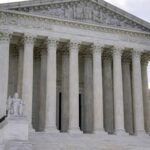“American and English historical precedents show a robust individual right”
On November 3, the U.S. Supreme Court will hear oral argument in New York State Rifle & Pistol Association v. Bruen. The case will decide whether the Second Amendment right to “bear arms” is an actual right. Or conversely, if law-abiding adults who pass a biometric background check and safety training can be denied a concealed carry permit simply because permitting officials only issue concealed carry permits when they feel that the applicant has a special need. The Supreme Court’s docket page for the case shows about three dozen amicus briefs filed on each side. In the next several weeks, I will write about some of those briefs. I’ll start with the amicus brief that I co-authored with George Mocsary (U. of Wyoming law school) and Joseph Greenlee (Firearms Policy Foundation).
The amici are law professors who teach and/or write on the Second Amendment, namely VC writers Randy Barnett (Georgetown) and Eugene Volokh (UCLA), plus Royce Barondes (Missouri), Nicholas Johnson (Fordham), Donald Kilmer (Lincoln), Michael O’Shea (Oklahoma City), Joseph Olson (Mitchell Hamline, emeritus), and Glenn Reynolds (Tennessee). Also joining the brief are Weld County, Colorado; Weld County Sheriff Steve Reams, the Independence Institute (the Denver think, where I am research director), and the Firearms Policy Foundation. Our brief focuses on legal history, particularly in the Founding Era and before. In this post, I will summarize parts of the brief, and, for some parts, provide additional background information.
Part I briefly looks at the text of the Second Amendment, which protects the right to “keep” arms and the right to “bear” arms. Rather than creating a hierarchy, the text protects both rights equally. Dictionaries cited in the Heller case—Thomas Sheridan (1796), Samuel Johnson (1773), and Noah Webster (1828, the first dictionary of American English)—all defined “bear” as to “carry” or “wear.”
By DAVID KOPEL



